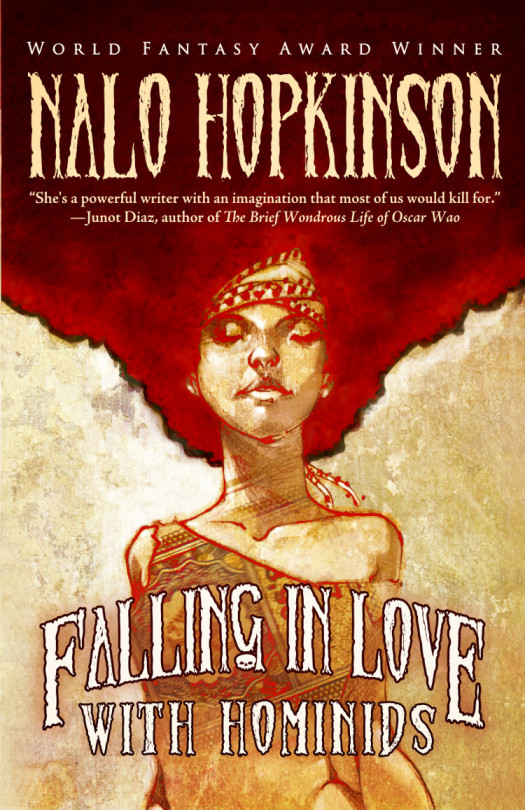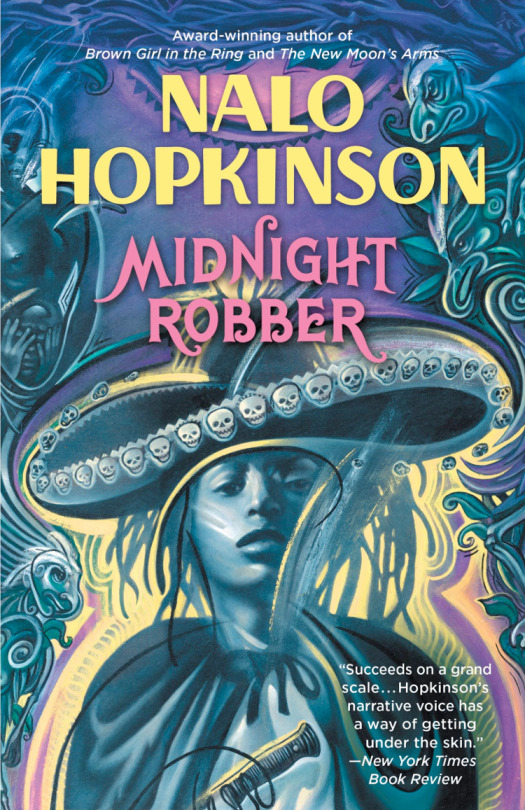Celebrating Nalo Hopkinson

On May 30th STRANGE HORIZONS ushered in a week long celebration of Nalo Hopkinson with
Reviews
The announcement of the Lemonade Award

‘Being Forced Into the World’: A Roundtable on the Works of Nalo Hopkinson with Kevin Jared Hosein, Brent Ryan Bellamy, and Portia Subran
In what ways do you see Nalo’s works being especially relevant today (geopolitically, environmentally, etc)?
Brent: I see Hopkinson’s work engaging a number of social justice conversations today. FALLING IN LOVE WITH HOMINIDS in particular, develops a broad array of narrative perspectives from the human and the non-human to the post-human. It raises questions about what it means to be companions and what it means to be strangers on this shared planet. While Hopkinson’s stories tend to avoid the proleptic, through the sheer difference and multiplicity of positions FALLING IN LOVE gets at a bigger picture of what it means to live together. This occurs within stories (for instance, the story about the alien sent back from the future to collection the shells of snails and her human interlocutor) and across the collection (for instance, what might the couple whose fire-breathing chicken gets stolen have to say to the character receiving flying lessons or the transfigured, horrifying bodies of adults in the opening story?). All of this is to say that I think Hopkinson’s work is vital and germane to the present because of its intervention across a number of genres and storytelling modes, all of which push readers to expand their sense of what living here on the Earth in a good way looks like or can be, even as these stories recognize the boundedness of each character’s experience and perspective.

Kevin: Hopkinson’s dystopias do not fall in line with the usual descriptors of the setting, however. It is quite easy for dystopia to fall in line with banal, “tried-and-true” truisms and axioms. Even the apocalypse cannot disestablish the systems and behaviours that plague us in the modern day. Police brutality still occurs in The Chaos, for example. Technology can do little to stymie the oppressions those of low social status experience. Many of the protagonists, young, female and black, must fend for themselves. Sexual abuse and child abuse are common conflicts. In a sense, sometimes there isn’t much difference from the experiences that many go through in the modern day, even with our constantly evolving technology. Perhaps Nalo’s work shows that the world right now is a dystopia for some, and will continue to be if we don’t address certain issues.
Portia: Although there are the elements of technology and folklore deeply entwined within her work, what really resonates with me as a reader are the social issues and interactions that are so familiar to me. In the previous discussion question, I spoke about children being forced to grow up quickly which is definitely something that happens today. In MIDNIGHT ROBBER, Tan Tan is sexually abused by her father for years and this is a crime we see being uncovered a lot right here in Trinidad and Tobago. Discrimination due to class, race or in MIDNIGHT ROBBER’s case, species, is something that absolutely happens within the world today. It is also crucial to examine the roles of servitude that people of colour play in MIDNIGHT ROBBER. Dealing with slavery and colonization is also explored. One example of this that struck me is the literal colonization of a planet in MIDNIGHT ROBBER.
The short story “Left Foot, Right”
“Allyou have this in a size nine?” Jenna puts the shiny red patent shoe down on the counter. Well, it used to be shiny. She’s been wearing it everywhere, and now it’s dulled by dust. It’s the left side of a high-heeled pump, pointy-toed, with large shiny fake rhinestones decorating the toe box. Each stone is a different size and colour, in a different cheap plastic setting. The red veneer has stripped off the heel of the shoe. It curls up off the white plastic heel base in strips. Jenna’s heart clenches. It’s exactly the kind of tacky, blinged-out accessory that Zuleika loves—loved—to wear.
The girl behind the counter is wearing a straw baseball cap, its peak pulled down low over her face. The girl asks, in a puzzled voice, “But don’t you bought exactly the same shoes last week?”
And the week before that, thinks Jenna. And the one before that. “I lost them,” she replies. “At least, I lost the right side”—she nearly chokes on the half truth—“so I want to replace them.” All around her, other salespeople help other customers. The people in the store zip past Jenna, half-seen, half-heard. This year’s soca road march roars through the store’s sound system. Last month, Jenna loved it. Now, any happy music makes her vexed.
“Jeez, what’s the matter with you now?” the girl says. Jenna startles, guiltily. She risks a look at the shoe store girl’s face. She hadn’t really done so before. She has been avoiding eye contact with people lately, afraid that if anyone’s two eyes make four with hers, the fury in hers will burn the heart out of the core of them.
But the girl isn’t looking at Jenna. With one hand, she is curling the peak of her cap to protect her eyes against the sun’s glare through the store windows. Only her small, round mouth shows. She seems to be peering into the display on the cash register. She slaps the side of the cash register. “Damned thing. It’s like every time I touch it, the network goes down.”
“Oh,” says Jenna. “Is not me you were talking to, then?”
The girl laughs, a childlike sound, like small dinner bells tinkling. “No. Unless it have something the matter with you too. Is there?”
and an audio version of the tale, read by Anaea Lay.
For more information on FALLING IN LOVE WITH HOMINIDS, visit the Tachyon page.
Cover art by Chuma Hill
Design by Elizabeth Story
